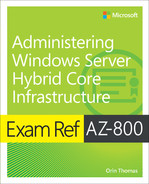Contents
Quick access to online references
Errata, updates, & book support
Chapter 1 Deploy and manage Active Directory Domain Services in on-premises and cloud environments
Skill 1.1: Deploy and manage AD DS domain controllers
Deploy and manage domain controllers on-premises
Deploy and manage domain controllers in Azure
Deploy read-only domain controllers (RODCs)
Troubleshoot flexible single master operations (FSMO) roles
Skill 1.2: Configure and manage multi-site, multi-domain, and multi-forest environments
Configure and manage forest and domain trusts
Configure and manage AD DS sites
Configure and manage AD DS replication
Skill 1.3: Create and manage AD DS security principals
Create and manage AD DS users and groups
Manage users and groups in multi-domain and multi-forest scenarios
Implement group managed service accounts (GMSAs)
Join Windows Servers to AD DS, Azure AD DS, and Azure AD
Skill 1.4: Implement and manage hybrid identities
Manage Azure AD Connect Synchronization
Implement Azure AD Connect cloud sync
Integrate Azure AD, AD DS, and Azure AD DS
Manage Azure AD Connect Health
Manage authentication in on-premises and hybrid environments
Configure and manage AD DS passwords
Skill 1.5: Manage Windows Server by using domain-based Group Policies
Implement Group Policy in AD DS
Implement Group Policy preferences in AD DS
Implement Group Policy in Azure AD DS
Chapter 2 Manage Windows Servers and workloads in a hybrid environment
Skill 2.1: Manage Windows Servers in a hybrid environment
Configure a target machine for WAC
Manage Azure hybrid services with WAC
Configure CredSSP or Kerberos Delegation for second hop remoting
Configure Just Enough Administration for PowerShell remoting
Skill 2.2: Manage Windows Servers and workloads by using Azure Services
Manage Windows Servers by using Azure Arc
Assign Azure Policy guest configuration
Deploy Azure services using the Azure VM extensions on non-Azure machines
Manage updates for Windows machines
Integrate Windows Servers with Log Analytics
Integrate Windows Servers with Microsoft Defender for Cloud
Manage IaaS VMs in Azure that run Windows Server
Create runbooks to automate tasks on target VMs
Implement Azure Automation for hybrid workloads
Implement Desired State Configuration to prevent configuration drift in IaaS machines
Chapter 3 Manage virtual machines and containers
Skill 3.1: Manage Hyper-V and guest virtual machines
Manage VM using PowerShell remoting, PowerShell Direct, and HVC.exe
Enable VM Enhanced Session Mode
Configure nested virtualization
Configure integration services
Configure Discrete Device Assignment
Configure hypervisor scheduling types
Implement high availability for virtual machines
Configure Hyper-V network adapter
Skill 3.2: Create and manage containers
Manage Windows Server container images
Configure container networking
Create Windows Server container images
Skill 3.3: Manage Azure Virtual Machines that run Windows Server
Configure continuous delivery for an Azure VM
Manage Azure VM network configuration
Chapter 4 Implement and manage an on-premises and hybrid networking infrastructure
Skill 4.1: Implement on-premises and hybrid name resolution
Create and manage zones and records
Configure DNS forwarding/conditional forwarding
Integrate Windows Server DNS with Azure DNS private zones
Skill 4.2: Manage IP addressing in on-premises and hybrid scenarios
Implement and configure the DHCP server role
Resolve IP address issues in hybrid environments
Create and manage IP reservations
Implement DHCP high availability
Skill 4.3: Implement on-premises and hybrid network connectivity
Implement and manage the Remote Access role
Implement and manage Azure Network Adapter
Implement and manage Azure Extended Network
Implement and manage Network Policy Server role
Implement Web Application Proxy
Implement Azure AD Application Proxy
Use Azure App Service Hybrid Connections
Chapter 5 Manage storage and file services
Skill 5.1: Configure and manage Azure File Sync
Create Azure File Sync Service
Migrate DFS to Azure File Sync
Skill 5.2: Configure and manage Windows Server File Shares
Configure Windows Server File Share access
Configure File Server Resource Manager quotas
Use additional FSRM functionality
Implement and configure Distributed File System
Skill 5.3: Configure Windows Server Storage
Configure and manage storage spaces
